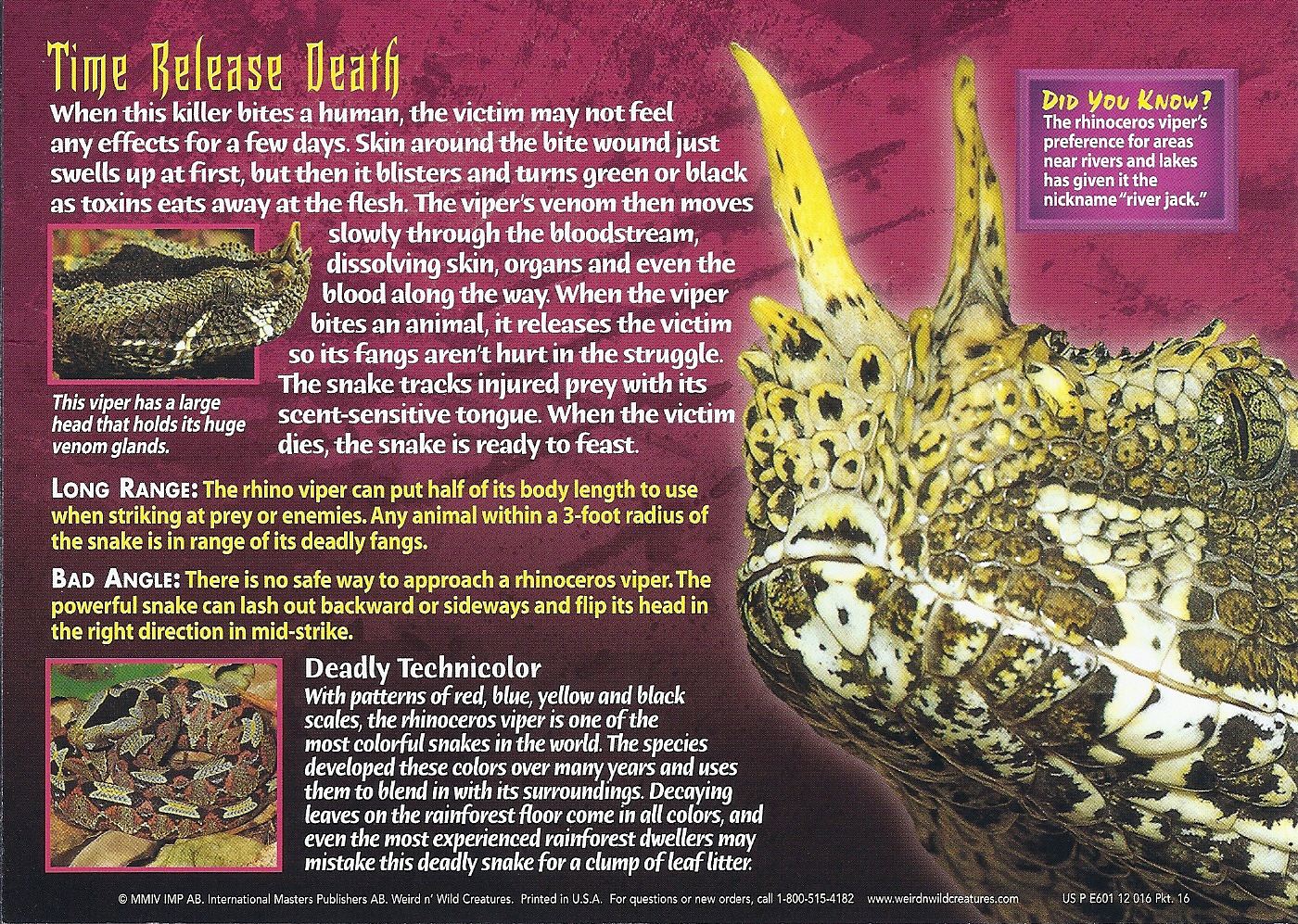

The scales of the snkae are heavily keeled. Like most of the vipers in the Bitis genus, the Rhinoceros Viper has a distinctive triangular shaped head. The Rhinoceros Viper is a stout, heavy bodied snake that can grow to lengths of 3-4 feet, with females typically growing larger than males. It was first identified in 1802 as Coluber nasicornis. The Rhinoceros Viper has the scientific name Bitis nasicornis. The species within this genus are known for their behaviour of inflating and deflating their bodies while hissing loudly in an attempt to scare off a potential threat. The Gaboon Viper is the largest viper reaching lengths of up to 7 feet while the Namaqua Dwarf Adder is the smallest, growing to less than 1 foot in length.

The Bitis genus contains both the largest and smallest species of Viper in the World. However, they can also be found in the Southern parts of the Arabian Peninsula in Yeman, Oman and Southern Saudi Arabia. This genus contains 15 different species of venomous snakes that are primarily found in sub-Saharan Africa. The Rhinoceros Viper belongs to the Bitis genus. The majority of venomous snakes in Australia are from the Elapid family.Įven though Australia has ‘Adders’, such sa the Common Death Adder, these ‘Adders’ are not related to the ‘Viper’ Adders of Africa and actually belong to the Elapid Family. Vipers are found throughout most of the world but an interesting fact about vipers is that they are not native to Australia. This is one of the most popular families of venomous snakes in the world along with the Elapid family. The Rhinoceros Viper belongs to the Viperidae or Viper family of snakes. In the Animal Kingdom, Taxonomy is used as the science and practice of classifying different species and sub-species based on their biological and genetic makeup. Many gaboon vipers are wild-caught and refuse to drink from still water, sometimes they must be offered moving water, or they can die from dehydration.Greg Hume, CC BY-SA 3.0, via Wikimedia Commons Rhinoceros Viper Taxonomy Humidity and Water: Humidity should be between 75% to 85%, installing ventilation fans on the enclosure helps to prevent respiratory infections. Thermostats should be used for any heating device to prevent burns. Heating can be accomplished with an appropriately sized radiant heat panel (RHP) or ceramic heat emitter (CHE), alternatively, heat tape or heat pads can be used. Temperatures should be dropped 10 degrees Fahrenheit (5.6 ℃) at nighttime. The basking spot should be 92 to 95 degrees Fahrenheit (33.3 to 35 ℃). Temperature: Enclosures should be set up to create a heat gradient – ambient temperature should be one side of the enclosure should be 81 to 86 degrees Fahrenheit (27.2 to 30 ℃) and the cooler side should be about 76 degrees Fahrenheit (24.4 ℃). Lighting: These animals are nocturnal so they do not require UVB lighting, however, some sort of daytime lighting should be used to keep their “internal clocks” in order. A hide box, wood, and leaf litter should be offered.

Substrate and Decor: They can be housed on cypress bedding, a soil mixture, aspen shavings, newspaper, or paper towels. In captivity, gaboon vipers have been recorded living up to 18 years.Įnclosure: Many people keep gaboon vipers in an 8 square foot enclosure (2.44 m2) 4-foot x 2-foot x 2-foot (122 cm x 61 cm x 61 cm) enclosure, but larger enclosures are preferred. Other threats include deforestation and forest degradation. The process of importing this species can be very dangerous for the animals and many of them die in transit to European and North American markets. Many of the gaboon vipers in the reptile-hobby have been taken from the wild or farm-raised. This species was evaluated as a species of Least Concern as of a 2012 IUCN assessment. Genus/species: Bitis gabonica (East African Gaboon Viper) Conservation Genus/species: Bitis rhinoceros (West African Gaboon Viper) Hatchlings are 9 to 14 inches (22.9 to 35.6 cm) in length, they are fully independent and do not require any parental care. After a seven-month gestation period, the female gives birth to 20 to 50 offspring. Gaboon vipers do not lay eggs, instead, they are viviparous. Gaboon vipers mate every two to three years between the months of September and December, which is the rainy season in Africa.


 0 kommentar(er)
0 kommentar(er)
